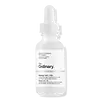What's inside
What's inside
 Key Ingredients
Key Ingredients

 Benefits
Benefits

 Concerns
Concerns

No concerns
 Ingredients Side-by-side
Ingredients Side-by-side

Water
Skin ConditioningGlycerin
HumectantButylene Glycol
HumectantPalmitoyl Tripeptide-1
Skin ConditioningPalmitoyl Tetrapeptide-7
Skin ConditioningPalmitoyl Tripeptide-38
Skin ConditioningSodium Hyaluronate
HumectantHydroxypropyl Cyclodextrin
MaskingPPG-26-Buteth-26
Skin ConditioningPEG-40 Hydrogenated Castor Oil
EmulsifyingPolyacrylate Crosspolymer-6
Emulsion StabilisingTrisodium Ethylenediamine Disuccinate
Carbomer
Emulsion StabilisingPolysorbate 20
EmulsifyingEthoxydiglycol
HumectantPhenoxyethanol
PreservativeChlorphenesin
AntimicrobialWater, Glycerin, Butylene Glycol, Palmitoyl Tripeptide-1, Palmitoyl Tetrapeptide-7, Palmitoyl Tripeptide-38, Sodium Hyaluronate, Hydroxypropyl Cyclodextrin, PPG-26-Buteth-26, PEG-40 Hydrogenated Castor Oil, Polyacrylate Crosspolymer-6, Trisodium Ethylenediamine Disuccinate, Carbomer, Polysorbate 20, Ethoxydiglycol, Phenoxyethanol, Chlorphenesin
Acer Saccharum Sap
HumectantGlycerin
HumectantTripropylene Glycol
AntioxidantPolyglycerin-3
HumectantBetaine
HumectantWater
Skin Conditioning1,2-Hexanediol
Skin ConditioningSqualane
EmollientButylene Glycol
HumectantButyrospermum Parkii Butter
Skin ConditioningSilica
AbrasiveHydroxyethyl Acrylate/Sodium Acryloyldimethyl Taurate Copolymer
Emulsion StabilisingPolyglyceryl-4 Oleate
EmulsifyingCarbomer
Emulsion StabilisingTheobroma Grandiflorum Seed Butter
Skin ConditioningMangifera Indica Seed Butter
Skin ConditioningAstrocaryum Murumuru Seed Butter
EmollientTromethamine
BufferingInulin Lauryl Carbamate
Emulsion StabilisingPropanediol
SolventSodium Polyacrylate
AbsorbentGlyceryl Acrylate/Acrylic Acid Copolymer
HumectantSodium Acrylates Crosspolymer-2
AbsorbentEthylhexylglycerin
Skin ConditioningCetearyl Alcohol
EmollientAdenosine
Skin ConditioningPvm/Ma Copolymer
Emulsion StabilisingAcer Rubrum Bark Extract
Skin ConditioningXanthan Gum
EmulsifyingCellulose Gum
Emulsion StabilisingTamarindus Indica Seed Gum
Emulsion StabilisingStearic Acid
CleansingSorbitan Isostearate
EmulsifyingSodium Surfactin
CleansingVaccinium Myrtillus Fruit Extract
Skin ConditioningPueraria Lobata Root Extract
HumectantCaprylyl Glycol
EmollientCetyl Hydroxyethylcellulose
Emulsion StabilisingGlucose
HumectantRutin
AntioxidantPhragmites Communis Extract
Skin ConditioningAcetyl Hexapeptide-8
HumectantTrifolium Pratense Extract
Skin ConditioningPalmitoyl Tripeptide-1
Skin ConditioningPalmitoyl Tetrapeptide-7
Skin ConditioningTocopherol
AntioxidantPhaseolus Lunatus Seed Extract
EmollientAcer Saccharum Sap, Glycerin, Tripropylene Glycol, Polyglycerin-3, Betaine, Water, 1,2-Hexanediol, Squalane, Butylene Glycol, Butyrospermum Parkii Butter, Silica, Hydroxyethyl Acrylate/Sodium Acryloyldimethyl Taurate Copolymer, Polyglyceryl-4 Oleate, Carbomer, Theobroma Grandiflorum Seed Butter, Mangifera Indica Seed Butter, Astrocaryum Murumuru Seed Butter, Tromethamine, Inulin Lauryl Carbamate, Propanediol, Sodium Polyacrylate, Glyceryl Acrylate/Acrylic Acid Copolymer, Sodium Acrylates Crosspolymer-2, Ethylhexylglycerin, Cetearyl Alcohol, Adenosine, Pvm/Ma Copolymer, Acer Rubrum Bark Extract, Xanthan Gum, Cellulose Gum, Tamarindus Indica Seed Gum, Stearic Acid, Sorbitan Isostearate, Sodium Surfactin, Vaccinium Myrtillus Fruit Extract, Pueraria Lobata Root Extract, Caprylyl Glycol, Cetyl Hydroxyethylcellulose, Glucose, Rutin, Phragmites Communis Extract, Acetyl Hexapeptide-8, Trifolium Pratense Extract, Palmitoyl Tripeptide-1, Palmitoyl Tetrapeptide-7, Tocopherol, Phaseolus Lunatus Seed Extract
 Reviews
Reviews

Ingredients Explained
These ingredients are found in both products.
Ingredients higher up in an ingredient list are typically present in a larger amount.
Butylene Glycol (or BG) is used within cosmetic products for a few different reasons:
Overall, Butylene Glycol is a safe and well-rounded ingredient that works well with other ingredients.
Though this ingredient works well with most skin types, some people with sensitive skin may experience a reaction such as allergic rashes, closed comedones, or itchiness.
Learn more about Butylene GlycolCarbomer is a polymer of acrylic acid. Its main role is to create a gel consistency.
A high amount of carbomer can cause pilling or balling up of products. Don't worry, most products contain 1% or less of carbomer.
Glycerin is already naturally found in your skin. It helps moisturize and protect your skin.
A study from 2016 found glycerin to be more effective as a humectant than AHAs and hyaluronic acid.
As a humectant, it helps the skin stay hydrated by pulling moisture to your skin. The low molecular weight of glycerin allows it to pull moisture into the deeper layers of your skin.
Hydrated skin improves your skin barrier; Your skin barrier helps protect against irritants and bacteria.
Glycerin has also been found to have antimicrobial and antiviral properties. Due to these properties, glycerin is often used in wound and burn treatments.
In cosmetics, glycerin is usually derived from plants such as soybean or palm. However, it can also be sourced from animals, such as tallow or animal fat.
This ingredient is organic, colorless, odorless, and non-toxic.
Glycerin is the name for this ingredient in American English. British English uses Glycerol/Glycerine.
Learn more about GlycerinPalmitoyl Tetrapeptide-7 (formerly Palmitoyl Tetrapeptide-3) is a lab-made peptide with anti-inflammatory and skin-repairing benefits. It's made up of four amino acids (glycine, glutamine, proline, and arginine) and palmitic acid (which helps it penetrate skin more effectively).
This ingredient helps reduce inflammation by limiting the production of interleukin-6 (IL-6), a chemical that triggers inflammatory responses, particularly after UV exposure.
Less inflammation = slower collagen breakdown and a longer-lasting, youthful appearance.
Palmitoyl Tetrapeptide-7 also stimulates collagen production and supports a healthier skin barrier.
Over time, this can improve skin firmness, hydration, and reduce the appearance of fine lines. It’s commonly paired with Palmitoyl Tripeptide-1 in the well-known Matrixyl 3000 complex for enhanced anti-aging effects.
This ingredient has been shown to be effective and safe in cosmetic use and you'll typically find it in small amounts (less than 0.01%).
Due to its palmitic acid base, it may not be safe for Malassezia folliculitis.
Read more about other common types of peptides here:
Learn more about Palmitoyl Tetrapeptide-7Palmitoyl Tripeptide-1 is also known as pal-GHK. It is made up of 3 amino acids and palmitic acid, a fatty acid that helps it absorb into skin more easily.
This peptide is as a signal peptide, meaning it tells the skin to produce more collagen. Collagen is the key protein that helps form the skin's structure and keep it plump, firm, and hydrated.
By boosting collagen production, this ingredient supports a stronger skin barrier and helps reduce the appearance of wrinkles.
You'll most likely see this ingredient paired with Palmitoyl Tetrapeptide-7 in the well-known Matrixyl 3000 complex. While results from in-house testing should be viewed cautiously, this peptide duo is among the most studied and widely used in modern skincare.
Due to its palmitic acid base, this ingredient may not be safe for Malassezia folliculitis.
Read more about other common types of peptides here:
Learn more about Palmitoyl Tripeptide-1Water. It's the most common cosmetic ingredient of all. You'll usually see it at the top of ingredient lists, meaning that it makes up the largest part of the product.
So why is it so popular? Water most often acts as a solvent - this means that it helps dissolve other ingredients into the formulation.
You'll also recognize water as that liquid we all need to stay alive. If you see this, drink a glass of water. Stay hydrated!
Learn more about Water